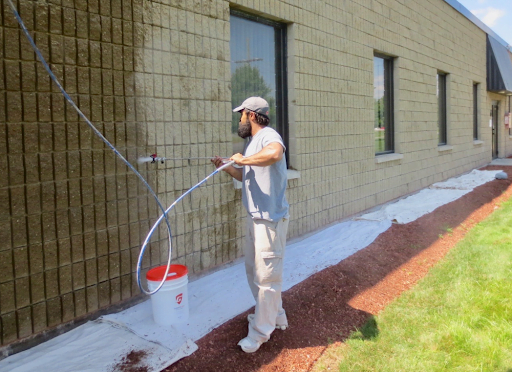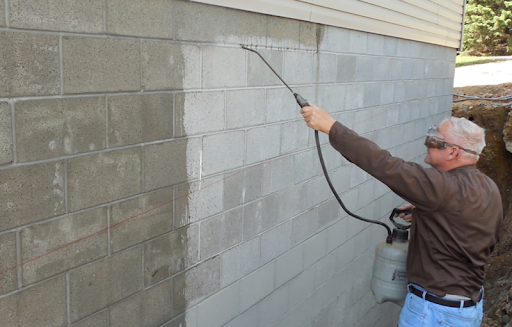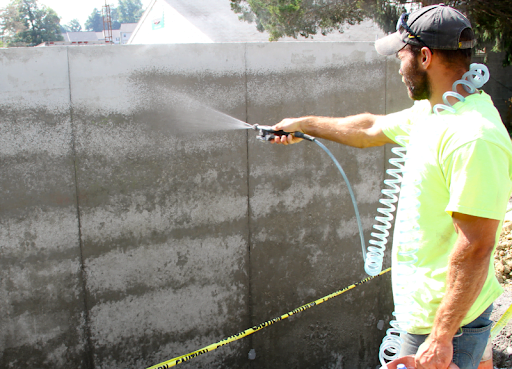
While concrete has a renowned reputation in architectural planning for being a resilient and hardwearing material, it is still susceptible to damage from elements such as water ingress, freeze-thaw cycles and chemical exposure. Even if it’s not exposed to the elements, the existence of pores and capillaries on its surface can lead to staining, discolouration, or spalling over time. Since this can be a problem for both interior and exterior walls, having proper protection is a key part of the equation.
Given the specific nature of the material, there’s a very particular way of going about it. There’s a lot of care and thought that goes into making an effective and long-lasting concrete wall sealer, with a plethora of formulas to fit every application. And it’s up to you to take the time to understand what each of these products can do for your walls and then apply them accordingly.

Why Seal a Concrete Wall?
In short, concrete is made up of tiny pores, capillaries and other microstructures that can be penetrated by liquid. While these are generally not enough to cause visible damage on their own, exposure to water and other liquids over time can contribute to a deterioration of the concrete’s structural integrity.
As time passes, the surface of a concrete wall can suffer from discolouration and staining due to water or chemical exposure. It can also become more susceptible to cracks and spalling due to freeze-thaw cycles. All of this can lead to a decrease in aesthetic appeal, as well as an increase in the likelihood of physical damage or decay.

By using concrete sealers, you can help keep it protected from wear and tear for longer periods of time. The products penetrate the surface and form a water-resistant bond, which can help prevent the absorption of moisture. It enters the pores and microstructures, forming a protective barrier that blocks liquids from passing through. This not only helps to reduce stains and discolouration but also helps protect the wall from any external damage.
What Are the Different Types of Concrete Sealers?
When it comes to the composition of a concrete wall sealer, there are two main types to consider: penetrating sealers and film-forming varieties. While they’re both equally efficient and effective at protecting walls, each option has its own unique set of strengths and weaknesses.
Penetrating Sealers

Perhaps the most common variety is penetrating sealers, which use compounds like silicates, silanes and fluoropolymers to form a tightly bonded barrier. These products consist of water-soluble compounds that are designed to penetrate deep into the concrete surface. Once applied, they go deep into the pores and microstructures, where they form a water-resistant barrier that helps keep out moisture.
Silicates are ideal for walls made of brick, stone and masonry, as they provide a high degree of protection against water ingress. Silanes are often used for gently porous concrete like driveways and sidewalks, given their ability to protect against staining and discolouration. Finally, fluoropolymers help prevent water from passing through extremely dense surfaces like foundations and basements, as well as providing protection against harsh chemicals.
Film Forming Sealers
Also known as surface-coating sealers, these are composed of acrylics, polyurethanes and epoxies that form a protective film on the very top layer of the concrete. They’re generally less effective than penetrating sealers, as their barrier doesn’t go very deep into the material but they do take less time to apply.
Acrylics in particular are quite appropriate for fending off dust and grime due to their glossy finish, whereas polyurethanes are a hard-wearing and non-yellowing variety that protects against harsh chemicals and stains. Epoxies are more suitable for industrial and commercial settings, as their ultra-strong film can withstand high levels of damage, with the most common applications being car parks and driveways.
How Do You Apply a Concrete Sealer?

Regardless of the type you decide to use, laying down the foundation of a concrete sealer is much the same process. The surface must be clean and free from any debris, which could potentially hinder the sealer’s performance. If there’s anything trapped in there, it should be cleared out with a wire brush or other abrasive tool prior to cleaning.
Once you’ve removed any debris from the surface, you should inspect the wall for any cracks or damage. These should be repaired using an appropriate mortar before you begin applying the sealer, as it will ensure that the sealer properly adheres to the material. Any spots or dips in the surface could hinder the results, with the sealer not being able to properly penetrate due to an uneven spread.
Once the wall is prepped and ready to go, you can begin applying the concrete sealer in thin layers across the entire surface. A general rule of thumb is to wait until each coat dries before applying the next one, as this will help ensure even coverage and long-term protection. Depending on the product, you may need to apply several coats in order to get the desired effect.
Safety Precautions While Applying Concrete Sealers
Finally, the way you handle the product plays a crucial role in determining the results. Before applying the coat, ensure that you’re wearing protective clothing such as gloves and a face mask to prevent any contact with the chemicals. Even if they’re not exactly hazardous, the vapours and fumes could still cause irritation to your eyes or skin.
Additionally, you should take steps to avoid any fire or electrical equipment that could be affected by the sealer’s fumes and vapours. Also, make sure to avoid any open flames or sparks when applying the product, as it could potentially ignite the sealer and cause serious damage.
When you’re preparing the product, take caution to not over-mix it, as this could result in an uneven spread. Manufacturers usually include instructions that indicate the appropriate amount of time to mix it, with the usual being between two to three minutes. Once you’re done applying it, the final step is to clean the tools you used and store the remaining sealer in a cool, dry place.
